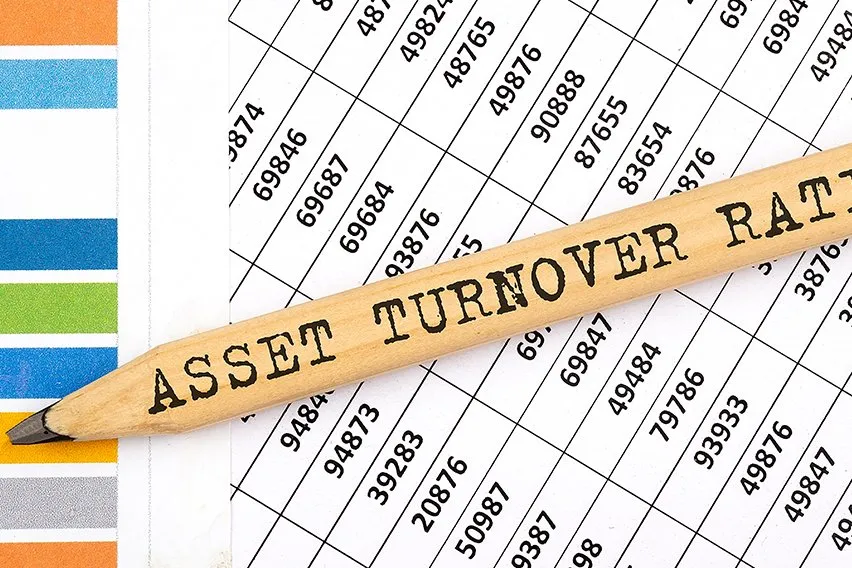How to Calculate Asset Turnover Ratio? Formula & Example

Asset turnover ratios are a measure of how effectively the company is using its assets to generate revenue. They can be used to compare one company with another. They can also be used internally by managers to evaluate their various divisions.
This article will discuss all you need to know about asset turnover ratios. You’ll learn what they are, how you can use them to analyze businesses and more.
Here’s What We’ll Cover:
What Is an Asset Turnover Ratio?
How to Calculate Asset Turnover Ratio
What is a Good Asset Turnover Ratio?
How to Use Asset Turnover Ratios to Analyze Companies
Asset Turnover Ratios Aren’t Everything
What Is an Asset Turnover Ratio?
Asset turnover ratios are a measure of how effectively the company is using its assets to generate revenue. More specifically, it is the ratio of sales divided by total assets. It shows how many dollars in sales are generated for each dollar of assets invested in the business.
Asset turnover ratios are also referred to as “sales to assets ratios”. They are used by both managers and investors. Asset turnover is most often measured on an annual basis. It can be calculated for a single month or any other period of time. A business’s asset turnover ratio will vary depending upon the industry in which it operates. The more a company focuses on the use of its assets, the higher the turnover rate will be. Good asset turnover ratios lead to more consistent cash flow.
A more complicated version of asset turnover is “fixed asset turnover”. This only counts the average dollar amount of fixed assets used each year to generate revenue. This is useful in industries where companies have large amounts of expensive machinery that sits idle for most of the year. Using average assets gives a better estimate of how effective they are at producing revenue. It can also be considered an efficiency ratio.

How to Calculate Asset Turnover Ratio
The formula for asset turnover ratio is: Revenue divided by average total assets
Here is an example.
Coca-Cola has sales of $27 billion, average total assets of $25 billion, and net income of $3.7 billion.
Asset Turnover Ratio = Sales/Average Total Assets = 27/25 = 1.1
The asset turnover ratio for Coca-Cola in this example is 1.1. This tells us that for every dollar of assets the company has, it generates $1.10 in sales.
What is a Good Asset Turnover Ratio?
A good asset turnover ratio depends upon your industry peers and how well similar companies are doing. Analyzing your income statement will help. A business that has higher asset turnover is considered to be more efficient. It’s using its resources to generate revenue better than lower-turnover companies. In other words, it’s making the most of its asset base.
A good rule of thumb is at least 1 for average asset turnover ratio. Ratios of companies with low working capital needs may get away with 0.5 or less. This depends on the nature of their business and the time period.
The highest asset turnover ratios are found in businesses that sell products with low variable costs. For example, the retail industry has very high turnover ratios. Retail companies have relatively low fixed costs. They can offset some of their other expenses by marking up the prices on their products.
How to Use Asset Turnover Ratios to Analyze Companies
You can compare your company’s current asset turnover ratio with others in the same industry to see how you stack up. This is useful for evaluating your own performance as well as deciding where you need improvement.
If you find that your competitors have higher turnover ratios than you, you’ll know that you need to either increase sales or decrease assets. This can be done in a number of ways. You could focus on more products with better profit margin. You could reduce prices on less profitable items. You can increase the volume of sales through advertising and promotions. You could also reduce costs by optimizing your supply chain, etc.
If your asset turnover ratio is higher than others in the industry, this means you are using your assets to generate more sales than your competitors. You may want to look at other factors to determine how you compare. For example, higher sales volume might indicate that the company is larger than yours, not necessarily better.
If you find that your ratio is lower than others in the industry, this means it’s time to identify where you can improve. Look at the assets you are using to generate revenue and see if there’s anything you can do with them better than others in the industry.
What Is an Example of a Company with High Asset Turnover?
Walmart is famous for its high asset turnover ratios. Not only does it have several stores, but it also has warehouses and distribution centres. It uses these assets to get products into stores, then sell it to customers. This generates a lot of revenue.
Walmart has had an asset turnover ratio of as high as 6. This means for every dollar of assets, they generate $6 in sales. That’s 3 times the industry average!

Asset Turnover Ratios Aren’t Everything
While asset turnover ratio is a good measure of how efficient management is at using company assets, it isn’t everything. There are many other things involved in running a company such as cost, market share and brand name recognition.
Asset turnover ratio is most helpful when looking at the same figures year over year or quarter over quarter. This gives you an idea of how your business is changing and growing over time.
Key Takeaways
Understanding asset turnover ratios is an important part of business management. It’s a measure that tells you how well your company uses its assets to generate revenue. In other words, it’s a business’ return on assets. This can be used as a benchmark for improvement or success over time.
This article discussed what asset turnover ratios are. It included examples of different industries and how they differ. You also learned about what a good asset turnover ratio is, how to use them to analyze companies and more. Hopefully this article helps you better understand asset turnover ratios.
Did you enjoy reading this guide? Head over to our resource hub for more great content!
RELATED ARTICLES

 What Are Franking Credits & How Do They Work?
What Are Franking Credits & How Do They Work? Marginal Cost: Definition, Formula & Examples
Marginal Cost: Definition, Formula & Examples What Should You Charge for House Cleaning in Australia?
What Should You Charge for House Cleaning in Australia? How Much Can You Earn From a Hobby Before Paying Tax?
How Much Can You Earn From a Hobby Before Paying Tax? Crowdfunding for Business: 12 Best Crowdfunding Sites for Startups
Crowdfunding for Business: 12 Best Crowdfunding Sites for Startups